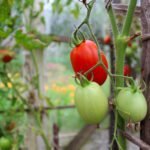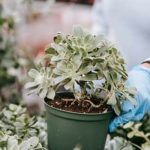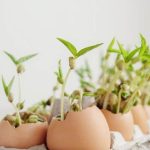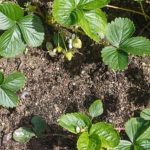Container gardening has become a popular choice for urban dwellers and those with limited outdoor space. This method allows individuals to grow a variety of vegetables, herbs, and flowers in containers, making it accessible to even those without a traditional garden plot. When considering container gardening, one of the essential factors to consider is the size of the containers in which you will be planting your vegetables.
The size of the containers for vegetable plants can greatly impact their growth and yield. It is crucial to choose containers that provide enough space for the roots to develop fully and support the growth of the plant. Generally, larger containers are preferred as they allow for more soil volume, which helps prevent plants from becoming root-bound and ensures better moisture retention.
In addition to proper sizing, using containers for vegetable gardening offers several benefits. Containers can be placed strategically to maximize sunlight exposure and airflow for optimal plant growth. They also allow for easy mobility, making it convenient to move plants around as needed.
Furthermore, container gardening can help control soil quality and drainage more effectively compared to traditional garden beds. Stay tuned to discover more about choosing the right size containers, best vegetables, proper soil management, watering techniques, and creative ideas for successful container gardening.
Choosing the Right Size Containers for Vegetable Plants
When it comes to container gardening, choosing the right size containers for your vegetable plants is crucial for their growth and overall success. The size of the container will directly impact the health and development of your plants, as well as their ability to produce a bountiful harvest.
One important factor to consider when selecting the size of your containers is the root system of the specific vegetable plant you are growing. Some vegetables, such as tomatoes and peppers, have deep root systems that require larger containers to allow for proper growth and development. On the other hand, shallow-rooted vegetables like lettuce or radishes can thrive in smaller containers.
It’s also essential to take into account the mature size of the vegetable plant itself. Larger plants such as zucchini or cucumbers will need larger containers to accommodate their size, while smaller plants like herbs or cherry tomatoes can thrive in more compact containers.
Additionally, consider the number of plants you plan to grow in each container – overcrowding can lead to stunted growth and poor yields. By selecting appropriate-sized containers based on these factors, you can set your vegetable plants up for success in your container garden.
Best Vegetables for Container Gardening
When it comes to choosing the best vegetables for container gardening, it’s important to consider the size of the plant, its root system, and its growth habits. Some vegetables are well-suited for growing in containers due to their compact nature and ability to thrive in confined spaces. One popular vegetable that works well in containers is cherry tomatoes. These small plants produce a bountiful harvest of sweet tomatoes and do not require a lot of space to grow.
Another excellent vegetable for container gardening is peppers. Whether you choose bell peppers or spicy varieties like jalapenos, peppers are relatively low-maintenance plants that can flourish in containers. Herbs such as basil, cilantro, and mint also thrive in containers and add fresh flavor to your cooking.
For those looking to grow leafy greens, spinach and lettuce are great choices for container gardening. These vegetables have shallow root systems and can be harvested continuously throughout the growing season. Additionally, carrots can be grown in deep containers as long as they have enough room for their taproots to develop. With the right size containers and proper care, these vegetables can thrive on patios, balconies, or anywhere with limited garden space.
| Vegetable | Container Size |
|---|---|
| Cherry tomatoes | 5-gallon container or larger |
| Peppers | 3-gallon container or larger |
| Herbs (e.g. basil, cilantro) | 1-gallon container each |
Proper Soil and Drainage for Container Gardening
Container gardening offers a convenient and flexible way to grow vegetables in limited spaces, such as patios, balconies, or small yards. When it comes to successful container gardening, proper soil and drainage are key factors to consider. The right soil mix ensures that your vegetable plants have the nutrients they need to thrive, while good drainage prevents waterlogging and root rot.
When choosing soil for your containers, opt for a high-quality potting mix specifically formulated for container gardening. These mixes are lightweight, well-draining, and usually contain added nutrients to support plant growth. Avoid using garden soil, as it can become compacted in containers and hinder proper root development. Additionally, garden soil may contain pests or diseases that could harm your vegetables.
In addition to choosing the right soil mix, ensuring proper drainage is essential for the health of your vegetable plants. Most vegetables prefer well-draining soil that allows excess water to escape easily. To improve drainage in your containers, consider adding materials like perlite or coarse sand to the soil mix. You can also place a layer of gravel or small stones at the bottom of your container before adding the soil to enhance drainage.
| Soil Mix | Drainage Material |
|---|---|
| High-quality potting mix | Perlite or coarse sand |
| Avoid garden soil | Gravel or small stones at the bottom of the container |
By providing your vegetable plants with the right soil mix and ensuring good drainage in their containers, you set them up for success in container gardening. Healthy roots lead to healthy plants that are more productive and resistant to pests and diseases. Take the time to prepare your containers with suitable soil and adequate drainage before planting your favorite vegetables to enjoy a bountiful harvest throughout the growing season.
Container Gardening Tips for Success
Container gardening can be a rewarding and convenient way to grow your own vegetables, herbs, and flowers right at home. One of the key factors to successful container gardening is choosing the right size containers for your plants. The size of the container you use can directly impact the health and growth of your vegetable plants.
Factors to Consider When Choosing Container Size
When deciding on what size containers to use for your vegetable plants, there are a few factors to consider. The first is the size of the plant at maturity – larger plants will require more space for their roots to grow.
Additionally, consider how many plants you want in each container and how much space they need to spread out. It’s also important to think about the weight of the container once it’s filled with soil and water – larger containers may be heavier and harder to move.
Choosing the Right Size Containers for Different Vegetables
Certain vegetables have different root systems and growth habits that may require specific container sizes. For example, deep-rooted vegetables like carrots or tomatoes will need deeper containers, while shallow-rooted vegetables like lettuce or radishes can thrive in shallower pots. As a general rule of thumb, most vegetable plants will require a container that is at least 12-18 inches deep and wide to allow for proper root development.
Tips for Success With Container Gardening
In addition to choosing the right size containers for your vegetable plants, there are other tips that can help ensure success with your container garden. Make sure your containers have adequate drainage holes to prevent waterlogged soil, use a high-quality potting mix specifically formulated for containers, and place your containers in a location that receives ample sunlight throughout the day.
By following these tips and selecting the appropriate size containers for your vegetable plants, you’ll be well on your way to a bountiful container garden harvest.
Watering and Fertilizing Your Vegetable Plants in Containers
Container gardening is a versatile and convenient way to grow vegetables, herbs, and flowers even if you don’t have a large backyard or garden space. One of the key factors to consider when engaging in container gardening is choosing the right size containers for your vegetable plants. The size of the container plays a crucial role in the growth and health of your plants.
Importance of Choosing the Right Size Containers
Selecting the proper size containers for your vegetable plants is essential because it directly impacts their root development, growth rate, and overall productivity. If a container is too small, it will restrict root growth and limit nutrient uptake, leading to stunted or unhealthy plants. On the other hand, using oversized containers may result in excessive water retention and potential root rot. Therefore, it’s vital to match the size of the container with the specific needs of each vegetable plant.
Factors to Consider When Selecting Container Sizes
When determining the size of containers for your vegetable plants, consider factors such as the mature size of the plant species, their water requirements, and spacing recommendations. Smaller vegetables like lettuce or herbs can thrive in smaller containers (6-12 inches in diameter), while larger plants like tomatoes or peppers may need bigger pots (at least 14-20 inches wide).
Additionally, vining crops such as cucumbers or peas may benefit from larger vertical containers to support their growth upwards. By understanding these considerations, you can optimize space and provide adequate growing conditions for your container garden’s success.
Container Gardening Tools and Supplies You’ll Need
When it comes to container gardening, having the right tools and supplies is essential for success. Whether you’re a beginner or a seasoned gardener, there are a few key items you’ll need to get started and maintain your vegetable plants in containers. Here’s a list of some essential tools and supplies for your container gardening endeavors:
- Containers: The size of the container plays a crucial role in the growth and development of your vegetable plants. When choosing containers, make sure they have adequate drainage holes to prevent waterlogging. The size of the container will depend on the specific vegetable plant you intend to grow – larger plants like tomatoes may require bigger containers compared to smaller plants like herbs.
- Soil: Use high-quality potting soil that is well-draining and nutrient-rich. Avoid using garden soil, as it may compact in containers and hinder root growth. Look for a mix specifically formulated for container gardening to provide optimal growing conditions for your vegetables.
- Trowel or hand shovel: A small trowel or hand shovel will come in handy for planting and transplanting seedlings into your containers. Make sure it’s sturdy and comfortable to use for extended periods of time.
In addition to these basic tools and supplies, consider investing in quality fertilizers, stakes or trellises for support, pruning shears for maintenance, watering cans or a drip irrigation system, and pest control measures like insecticidal soap or neem oil. Having the right tools at your disposal will make container gardening more manageable and enjoyable, ensuring healthy growth and abundant harvests of fresh vegetables at your fingertips.
Remember that proper maintenance of your tools such as cleaning after use will help prolong their lifespan and ensure they remain effective throughout each growing season. With the right tools and supplies on hand, you’ll be well-equipped to embark on a successful container gardening journey with bountiful yields of homegrown vegetables right at home.
Creative Container Ideas for Small Spaces
Container gardening is a versatile and practical way to grow vegetables even in small spaces. When it comes to choosing the right size containers for your vegetable plants, it’s essential to consider the root system of each plant and provide enough room for optimal growth. Here are some guidelines on what size containers to use for different types of vegetables:
1. Small Vegetables (e.g. lettuce, radishes, herbs): For small vegetables with shallow roots, such as lettuce or herbs, you can use containers that are at least 6-8 inches deep and wide enough to accommodate multiple plants.
2. Medium Vegetables (e.g. tomatoes, peppers, eggplant): Medium-sized vegetables like tomatoes or peppers require slightly larger containers, typically around 12-18 inches deep and wide to allow for adequate root development.
3. Large Vegetables (e.g. cucumbers, zucchini, squash): For large vegetables that have extensive root systems like cucumbers or zucchini, it’s best to use containers that are at least 18-24 inches deep and wide for optimal growth.
When selecting containers for your vegetable plants in small spaces, also consider using hanging baskets, vertical planters, or window boxes to maximize space. These creative container ideas not only add visual interest but also help make the most of limited gardening areas. With the right size containers and some creativity, you can enjoy a bountiful harvest of fresh vegetables right at home.
Conclusion
Container gardening is a versatile and convenient way to grow vegetables, herbs, and flowers even in limited spaces. By choosing the right size containers for your vegetable plants, you can ensure their proper growth and development. From small pots on a balcony to larger containers on a patio, there are numerous options available for aspiring container gardeners.
When deciding on the size of containers for your vegetable plants, it’s important to consider the mature size of the plant as well as its root system. Smaller plants like herbs or lettuce can thrive in smaller containers, while larger vegetables like tomatoes or peppers may require larger pots to accommodate their growth. Additionally, ensuring proper soil composition and drainage is crucial for the success of your container garden.
Whether you’re a beginner or an experienced gardener looking to try something new, container gardening offers a rewarding experience with relatively low maintenance compared to traditional gardening. By following the tips and guidelines provided in this article, you can create your own thriving container garden and enjoy fresh produce right at your doorstep. Start small with a few containers and gradually expand your collection as you gain confidence in your skills as a container gardener.
Frequently Asked Questions
What Size Containers for Vegetable Gardening?
When choosing the size of containers for vegetable gardening, it is important to consider the space that each plant requires for optimal growth. Larger plants like tomatoes or peppers will need larger containers, typically around 5 gallons or more. Smaller plants like herbs can thrive in smaller containers, around 1-2 gallons.
How Many Vegetables Can I Grow in a 5 Gallon Container?
In a 5 gallon container, you can grow a variety of vegetables such as lettuce, spinach, radishes, and even some dwarf varieties of tomatoes or peppers. However, it’s important to note that larger plants like zucchini or cucumbers may not thrive in such a small container due to space constraints that could impact their growth.
What Size Planter Box for Vegetables?
The size of the planter box for vegetables will depend on the types of vegetables you wish to grow. For smaller plants like lettuce or herbs, a shallow planter box with a depth of about 6-8 inches may suffice.
For larger plants like tomatoes or root vegetables, opt for a deeper planter box with at least 12 inches depth to accommodate their root systems. It’s always better to go bigger than too small when selecting a planter box for vegetables to ensure they have ample room to grow and thrive.

If you’re looking to get into vegetable gardening, or are just looking for some tips on how to make your current garden better, then you’ve come to the right place! My name is Ethel and I have been gardening for years. In this blog, I’m going to share with you some of my best tips on how to create a successful vegetable garden.





